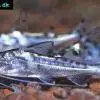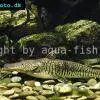Highwaterman catfish - Hypophthalmus edentatus
Scientific name: Hypophthalmus edentatus
Common name: Highwaterman catfish
Family: Pimelodidae
Usual size in fish tanks: 25 - 30 cm (9.84 - 11.81 inch)
014
Recommended pH range for the species: 5.5 - 7
Recommended water hardness (dGH): 4 - 19°N (71.43 - 339.29ppm)
0°C 32°F30°C 86°F
Recommended temperature: 22 - 25 °C (71.6 - 77°F)
The way how these fish reproduce: Spawning
Where the species comes from: South America
Temperament to its own species: aggressive/territorial
Temperament toward other fish species: aggressive/territorial
Usual place in the tank: Bottom levels
Overview
The Highwaterman Catfish (Hypophthalmus edentatus) is a large, filter-feeding species native to South America. Its unique feeding habits and territorial nature make it a challenging species to keep in an aquarium. Due to its size and high oxygen requirements, it is best suited for experienced aquarists with large tanks and advanced filtration systems.
Origin and Natural Habitat
Highwaterman Catfish are found in the Amazonian and Orinoco River basins. Juveniles typically inhabit the lower sections of streams, while adults migrate toward estuaries and brackish waters. They prefer areas with muddy substrates, where they can efficiently filter-feed on plankton.
Appearance and Size
These catfish grow to an adult size of approximately 25 - 30 cm (9.84 - 11.81 inches). Their elongated body shape and specialized gill rakers allow them to strain food particles from the water efficiently.
Tank Requirements
- Tank Size: A minimum of 500 liters (130 gallons) is recommended due to their size and need for open swimming space.
- Water Parameters:
- pH: 5.5 - 7.0
- Water Hardness: 4 - 19°N (71 - 339 ppm)
- Temperature: 22 - 25°C (71.6 - 77°F)
- Tank Setup: Provide strong filtration and high oxygen levels to replicate their natural environment. Use muddy or sandy substrates and ensure an open swimming area.
Temperament and Tank Mates
Highwaterman Catfish are territorial and aggressive, particularly toward their own species and other bottom dwellers. They should be housed with large, non-aggressive fish that can tolerate their size and activity. Avoid keeping them with small fish, as territorial disputes may arise.
Feeding and Diet
This species has a highly specialized diet and is not suitable for beginners:
- Their primary food source consists of phytoplankton and copepods.
- They filter-feed using their long gill rakers.
- They lack teeth and cannot consume regular fish foods.
- Feeding them in captivity can be difficult, as replicating their natural diet is challenging.
Sexing
There are no visible differences between males and females.
Breeding
There are no known cases of successful breeding of Highwaterman Catfish in home aquariums. Their reproductive habits remain largely undocumented in captivity.
Lifespan
With proper care, Hypophthalmus edentatus can live between 16 to 17 years in an optimal environment.
Health and Maintenance
Due to their high oxygen requirements and large size, maintaining pristine water conditions is crucial:
- Use high-capacity filtration to handle their biological load.
- Perform frequent water changes to maintain water quality.
- Ensure adequate oxygenation using air stones or additional aeration devices.
Conclusion
The Highwaterman Catfish (Hypophthalmus edentatus) is a highly specialized species that requires a unique diet, large tank, and high oxygen levels. Due to its territorial nature and challenging feeding habits, it is best suited for advanced aquarists with experience in maintaining large, filter-feeding fish.

 Jello
Jello  Spotted
Spotted  Ornate
Ornate  Pictus
Pictus  Tiger
Tiger